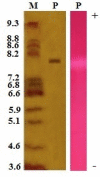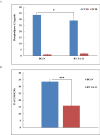Egyptian cobra (Naja haje haje) venom phospholipase A2: a promising antiviral agent with potent virucidal activity against simian rotavirus and bovine coronavirus
- PMID: 35895237
- PMCID: PMC9326960
- DOI: 10.1007/s00203-022-03139-7
Egyptian cobra (Naja haje haje) venom phospholipase A2: a promising antiviral agent with potent virucidal activity against simian rotavirus and bovine coronavirus
Abstract
Viral infections are linked to a variety of human diseases. Despite the achievements made in drug and vaccine development, several viruses still lack preventive vaccines and efficient antiviral compounds. Thus, developing novel antiviral agents is of great concern, particularly the natural products that are promising candidates for such discoveries. In this study, we have purified an approximately 15 kDa basic phospholipase A2 (PLA2) enzyme from the Egyptian cobra Naja haje haje venom. The purified N. haje PLA2 showed a specific activity of 22 units/mg protein against 6 units/mg protein for the whole crude venom with 3.67-fold purification. The antiviral activity of purified N. haje PLA2 has been investigated in vitro against bovine coronavirus (BCoV) and simian rotavirus (RV SA-11). Our results showed that the CC50 of PLA2 were 33.6 and 29 µg/ml against MDBK and MA104 cell lines, respectively. Antiviral analysis of N. haje PLA2 showed an inhibition of BCoV and RV SA-11 infections with a therapeutic index equal to 33.6 and 16, respectively. Moreover, N. haje PLA2 decreased the BCoV and RV SA-11 titers by 4.25 log10 TCID50 and 2.5 log10 TCID50, respectively. Thus, this research suggests the potential antiviral activity of purified N. haje PLA2 against BCoV and RV SA-11 infections in vitro.
Keywords: Antiviral activity; COVID-19; Cobra; Phospholipase A2; Rotavirus; Venom.
© 2022. The Author(s).
Conflict of interest statement
The authors have no relevant financial or non-financial interests to disclose.
Figures





Similar articles
-
An in-depth exploration of snake venom-derived molecules for drug discovery in advancing antiviral therapeutics.Heliyon. 2024 Sep 2;10(18):e37321. doi: 10.1016/j.heliyon.2024.e37321. eCollection 2024 Sep 30. Heliyon. 2024. PMID: 39323826 Free PMC article. Review.
-
Proteomic analysis of three medically important Nigerian Naja (Naja haje, Naja katiensis and Naja nigricollis) snake venoms.Toxicon. 2021 Jul 15;197:24-32. doi: 10.1016/j.toxicon.2021.03.014. Epub 2021 Mar 26. Toxicon. 2021. PMID: 33775665
-
A Neurotoxic Snake Venom without Phospholipase A2: Proteomics and Cross-Neutralization of the Venom from Senegalese Cobra, Naja senegalensis (Subgenus: Uraeus).Toxins (Basel). 2021 Jan 14;13(1):60. doi: 10.3390/toxins13010060. Toxins (Basel). 2021. PMID: 33466660 Free PMC article.
-
Anti-Cancer Effect of Moroccan Cobra Naja haje Venom and Its Fractions against Hepatocellular Carcinoma in 3D Cell Culture.Toxins (Basel). 2021 Jun 4;13(6):402. doi: 10.3390/toxins13060402. Toxins (Basel). 2021. PMID: 34199838 Free PMC article.
-
Bee Venom and Its Two Main Components-Melittin and Phospholipase A2-As Promising Antiviral Drug Candidates.Pathogens. 2023 Nov 15;12(11):1354. doi: 10.3390/pathogens12111354. Pathogens. 2023. PMID: 38003818 Free PMC article. Review.
Cited by
-
An in-depth exploration of snake venom-derived molecules for drug discovery in advancing antiviral therapeutics.Heliyon. 2024 Sep 2;10(18):e37321. doi: 10.1016/j.heliyon.2024.e37321. eCollection 2024 Sep 30. Heliyon. 2024. PMID: 39323826 Free PMC article. Review.
References
-
- Abid NS, Rouis Z, Lassoued MA, Sfar S, Aouni M. Assessment of the cytotoxic effect and in vitro evaluation of the anti-enteroviral activities of plants rich in flavonoids. J Appl Pharm Sci. 2012;2(5):74–78. doi: 10.7324/JAPS.2012.2532. - DOI
-
- Abid I, Jemel I, Alonazi M, Bacha AB. A new group II phospholipase A2 from Walterinnesiaaegyptia venom with antimicrobial, antifungal, and cytotoxic potential. Processes. 2020;8(12):1560. doi: 10.3390/pr8121560. - DOI
MeSH terms
Substances
LinkOut - more resources
Full Text Sources

